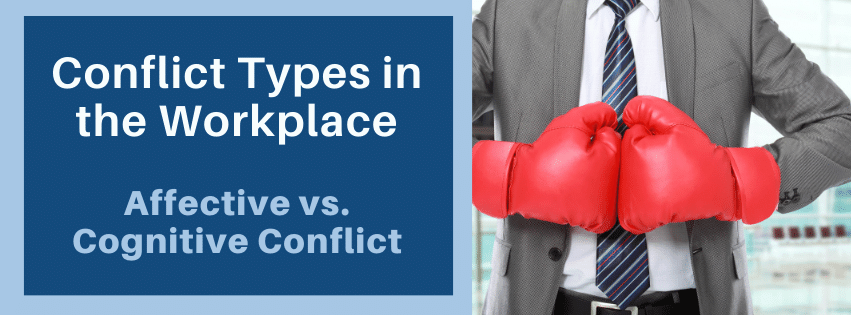
In the realm of team dynamics, understanding the nuances of conflict types is paramount. Two of the most prevalent conflict types in the workplace that teams encounter are affective and cognitive conflicts. While both can significantly impact team dynamics, their nature, causes, and outcomes differ. Let’s delve deeper into these two conflict types:
Affective Conflict
Affective conflict is fundamentally rooted in emotions, roles, or interpersonal relationships, focusing predominantly on the “who” and the “how” rather than the task at hand.
This nature of conflict often gives rise to issues stemming from disagreements about who should undertake a task or how it should be executed. Moreover, personal disagreements, perceived slights, and misunderstandings can further fuel such conflicts.
The effects of affective conflicts are largely negative, leading to diminished team cohesion, restricted judgment, and reduced overall performance. Individuals embroiled in this type of conflict might experience physiological signs such as an increased heart rate, feelings of anger, and a triggered “fight or flight” response.
If affective conflict types in the workplace are not addressed promptly, they can escalate to more serious problems, fostering mistrust and resentment among team members and causing a significant breakdown in communication. It is, therefore, imperative to manage these conflicts effectively to maintain a harmonious and productive team environment.
Cognitive Conflict
Cognitive conflict is characterized by its focus on tasks and processes, centralizing on the “what,” “when,” and “why” of a task or project. This type of conflict can have its benefits, especially in its early stages where it can foster constructive discussions.
It can pave the way for enhanced clarity and focus on necessary timelines, encouraging debates regarding the importance of various tasks.
When harnessed effectively, cognitive conflict can significantly uplift team performance, inspiring brainstorming sessions that leverage the diverse experiences of team members to create prioritized execution roadmaps.
However, it is crucial to facilitate these conflicts properly to reap the benefits. If not managed well, cognitive conflicts have the potential to escalate into affective conflicts, particularly when discussions veer off from the task at hand and encroach into personal territories.
Thus, while cognitive conflict types in the workplace can be a catalyst for innovation and improved team dynamics, it requires careful handling to prevent negative outcomes.
RELATED: Conflict Between Coworkers. Recognizing and Understanding Workplace Dynamics
Differences Between These Conflicts Types in the Workplace
- Source of Conflict: While affective conflict is emotionally driven and often arises from interpersonal relationships, cognitive conflict is task-oriented and stems from differences in perspectives on tasks.
- Impact on Teams: Affective conflict is generally detrimental, leading to mistrust and reduced team cohesion. In contrast, cognitive conflict, when managed well, can be beneficial, driving innovation and problem-solving.
- Resolution Approach: Affective conflicts require immediate intervention, often involving open dialogue, empathy, and sometimes mediation. Cognitive conflicts, on the other hand, can be channeled into productive discussions, brainstorming sessions, and collaborative problem-solving.
Chart: Affective vs. Cognitive Conflict Types in the Workplace
| Conflict Analysis Dimensions | Affective Conflict | Cognitive Conflict |
|---|---|---|
| Nature | Rooted in emotions, roles, or interpersonal relationships. Focuses on the “who” and “how”. | Revolves around tasks and processes. Focuses on the “what,” “when,” and “why”. |
| Root Cause | Disagreements about roles, perceived slights, misunderstandings. | Differences in perspectives on tasks, timelines, and importance. |
| Effects on Team | Diminishes team cohesion, restricts judgment, reduces performance. | Can enhance clarity and focus, inspire brainstorming, and lead to prioritized execution when managed effectively. |
| Physiological Signs | Increased heart rate, feelings of anger, “fight or flight” response. | Not typically associated with physiological responses unless it escalates. |
| Outcome if Unmanaged | Mistrust, resentment, breakdown in communication. | Can escalate into affective conflict, especially when discussions become personal. |
| Resolution Approach | Requires immediate intervention, open dialogue, empathy, potential mediation. | Can be channeled into productive discussions, brainstorming sessions, and collaborative problem-solving. |
Conclusion
In conclusion, while both affective and cognitive conflicts are inherent in team dynamics, understanding their nature and nuances is crucial. With the right strategies and a proactive approach, teams can navigate these conflicts effectively, ensuring they serve as catalysts for growth and collaboration rather than obstacles.
Summit Can Help!
Interested in enhancing your team’s dynamics? Explore Summit’s range of team-building activities and workshops tailored to address the unique challenges faced by teams today. Contact us to get started.

